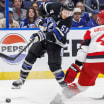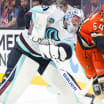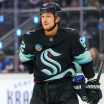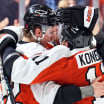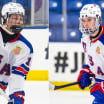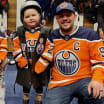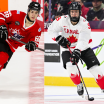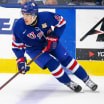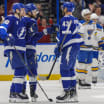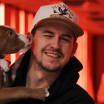The NHL and the NHL Players' Association have agreed in principle on a memorandum of understanding for a four-year extension of the NHL/NHLPA Collective Bargaining Agreement, through the 2025-26 season, the League and union announced Monday. The sides also agreed to to resume play on Aug. 1 as part of protocols for Phases 3 and 4 of the NHL Return to Play Plan.
NHL, NHLPA agree to extend CBA, start play Aug. 1
Will go through 2025-26 season if ratified; camps to begin Monday
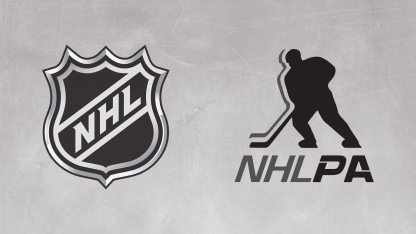
The opening of training camps in the teams' local markets, which is the start of Phase 3, is scheduled for July 13. Teams will then travel July 26 to one of two hub cities, where they will begin Phase 4, the resumption of play, with the Stanley Cup Qualifiers starting Aug. 1. The hub cities have not been announced.
The CBA extension and agreement on protocols for Phases 3 and 4 are subject to ratification by the NHL Board of Governors and NHLPA membership. The NHLPA said it will announce the players' decision on Friday.
The current CBA, ratified in January 2013, was scheduled to expire Sept. 15, 2022. With this extension, it would expire Sept. 15, 2026.
The extended agreement will enable planning for an international calendar and events including the NHL All-Star Game, NHL Winter Classic and NHL Stadium Series.
The NHL and NHLPA each declined its option to reopen this agreement in September 2019, a move that would have triggered its expiration Sept. 15, 2020. The sides instead decided to continue discussions about an extension that began during the 2019 offseason.
Negotiations continued after the NHL paused the season March 12 due to concerns surrounding coronavirus and have been a part of the process of determining the NHL Return to Play Plan, which was announced May 26 and will include 24 teams competing for the Stanley Cup.
Play will resume with the qualifiers, 16 teams playing eight best-of-5 series and a round-robin among the top four teams in points percentage in each conference to determine seeding for the Stanley Cup Playoffs.
NHL Phased Return to Sport Protocol: Phase 3 | Phase 4
Teams were permitted to reopen their facilities June 8 for voluntary on-ice and off-ice workouts under Phase 2 of the Return to Play Plan. Workout groups initially were restricted to six players and limited staff but later were expanded to a maximum of 12 players.
For Phase 3, players will be permitted to participate in full team activities on and off the ice. In addition, coaches, general managers and hockey operations personnel will be allowed to have direct interactions with players and conduct typical training camp activities while following preventative measures, including enhanced testing for COVID-19 and diligent hygiene practices designed to prevent the spread of the virus.
For Phase 4, the 24 teams will travel to the two hub cities, one for the 12 Eastern Conference teams and the other for the 12 Western Conference teams.
The teams will be housed in Phase 4 Secure Zones, which will include hotels, restaurants, practice facilities and the arena where exhibition, qualifier and postseason games will be played. Each person inside the secure zone, including players, coaches, team and NHL personnel, arena and practice facility staff, and vendors and service providers will be tested daily for COVID-19 and have symptom screening and temperature checks.
Some of the key points in the Phase 3 protocols include: rosters being limited to 30 skaters but allowing for an unlimited number of goalies per team; participation being limited to players who are eligible for the playoffs; and COVID-19 testing being required for players, team personnel and other personnel who will be in the vicinity of players (ice and building maintenance, security, etc.) 48 hours prior to returning to team facilities and every other day after that.
Phase 4 protocols include: rosters being limited to 31 players (including goalies); a maximum of 52 individuals per team (including ownership, players, coaches, executives and staff) being permitted inside the secure zone; and daily testing, symptom checks and temperature screenings for each person.
In the Eastern Conference Qualifiers, the Boston Bruins (44-14-12, .714 points percentage), Tampa Bay Lightning (43-21-6, .657), Washington Capitals (41-20-8, .652) and Philadelphia Flyers (41-21-7, .645) will play in the round-robin.
The four best-of-5 series in the East are the Pittsburgh Penguins (40-23-6, .623) vs. the Montreal Canadiens (31-31-9, .500); the Carolina Hurricanes (38-25-5, .596) vs. the New York Rangers (37-28-5, .564); the New York Islanders (35-23-10, .588) vs. the Florida Panthers (35-26-8, .565); and the Toronto Maple Leafs (36-25-9, .579) vs. the Columbus Blue Jackets (33-22-15, .579).
In the Western Conference Qualifiers, the defending Stanley Cup champion St. Louis Blues (42-19-10, .662), Colorado Avalanche (42-20-8, .657), Vegas Golden Knights (39-24-8, .606) and Dallas Stars (37-24-8, .594) will play in the round-robin.
The four best-of-5 series in the West are the Edmonton Oilers (37-25-9, .585) vs. the Chicago Blackhawks (32-30-8, .514); the Nashville Predators (35-26-8, .565) vs. the Arizona Coyotes (33-29-8, .529); the Vancouver Canucks (36-27-6, .565) vs. the Minnesota Wild (35-27-7, .558); and the Calgary Flames (36-27-7, .564) vs. the Winnipeg Jets (37-28-6, .563).
The losing teams from the qualifiers will have a chance at the No. 1 pick in the 2020 NHL Draft in the Second Phase of the NHL Draft Lottery.
The teams that advance from the qualifiers will remain in the two hub cities for the first two rounds of the playoffs. The four teams that advance past the second round will convene at one hub city to be identified for the conference finals and Stanley Cup Final.
